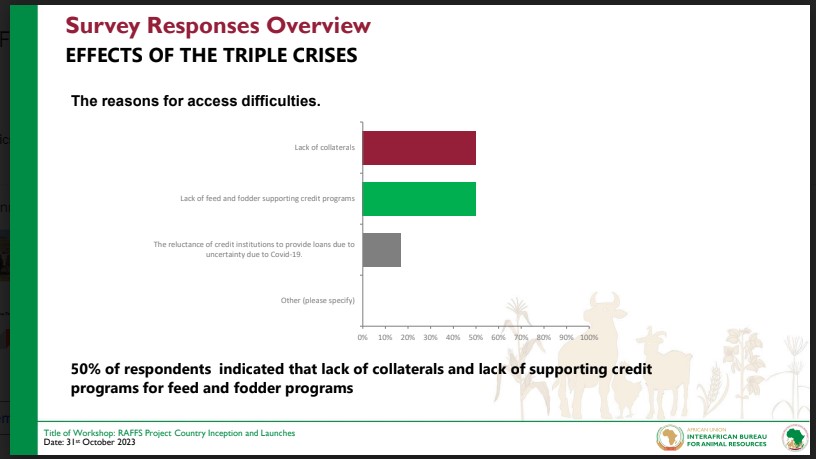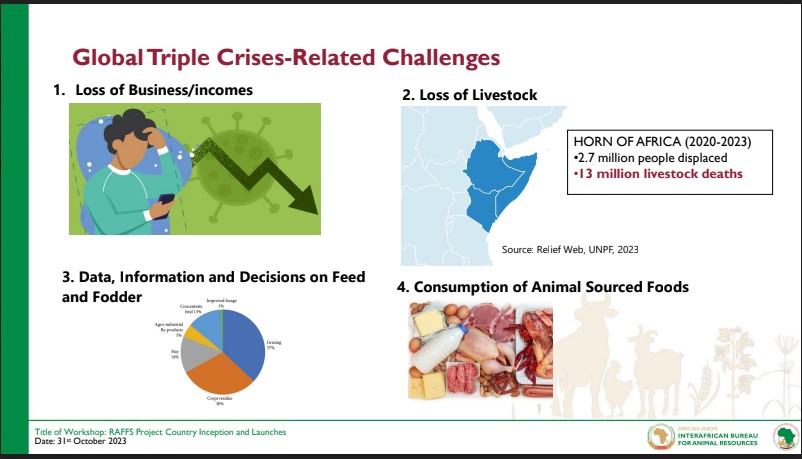The Kenyan government has said the country faces a shortage of livestock feed and fodder, and sustainable measures are needed to reverse the situation.
Dr Stanley Mutua, the Head of Animal Feeds and Nutrition at the Ministry of Agriculture’s State Department for Livestock Development, said Kenya needs 55 million metric tons of feed annually but only provides 40 percent of this, with 46.3 percent going to post-harvest losses. “The Ministry of Agriculture and Livestock Development is committed to driving sustainable feed and nutrition security system through building consensus with stakeholder farmers,” he said.
Global triple crises in Africa’s feed and fodder sector, dubbed three Cs: COVID-19, climate change, and conflict, affected production. The value chain was affected by COVID-19 restrictions, climate change effects of drought and flooding, and the restrictions on importation due to the Ukraine and Russian conflict.

Speaking during the launch of the Kenya chapter of the Resilient African Feed and Fodder Systems Project’ (RAFFS) and the Assessments in Naivasha, Nakuru County, Dr Mutua said the country wants to move from small to large-scale feed production.
RAFFs is an initiative of the African Union-InterAfrican Bureau for Animal Resources (AU-IBAR) and the Bill and Melinda Gates Foundation that seeks to harness evidence-driven solutions for short-term interventions to enhance access to affordable and quality feed and fodder. Kenya’s RAFFs priority value chains are dairy, red meat, and live animals.
According to the Food and Agriculture Organisation (FAO), Kenya’s livestock sector accounted for 4.4 percent of the country’s Gross Domestic Product, equivalent to 22 million dollars as of 2017 statistics. As of 2017 data, the country’s animal population comprised 44.6 million poultry, 18.8 million cattle, 26.7 million goats, 18.9 million sheep, 3.2 million camels, 1.9 million donkeys, and 0.5 million pigs.
Demand for livestock products will increase
According to FAO, Kenya’s beef production stands at 588,000 metric tons and cow milk production at 4.1 billion liters per year, and the demand for livestock products is projected to increase exponentially, driven by population growth by the year 2050. The study titled Future of Livestock in Kenya 2019 shows that by the year 2050, meat and cow milk consumption will increase by 1.4 and 6.6 million metric tons annually, respectively.
RAFFs is expected to provide data on 3Cs on feed security to inform policy and drive feed agenda. The linking of producers and feed users is expected to complete the value chain and ensure sustainable production. Mutua said post-harvest losses and low mechanization and transport connectivity are among the value chain challenges.

Director of Livestock Production Bishar Elmi emphasized that as we invest in livestock feed and fodder, we must also invest in animal health to ensure optimum production. He noted that after independence, the market infrastructure was immature, and the system collapsed because there was no focus on the livestock sector. “Great opportunities exist in the livestock feed and fodder sector with growing human population, demand for animal protein, and national economic growth,” Elmi said.
Speaking during the launch of the Kenya chapter of RAFFs and the National Chapter of Africa Women in Animal Resources Farming and Agribusiness Network (AWARFA-N) Kenya, AU-IBAR Director Dr Huyam Salih said livestock feeding constitutes 60-70 percent of the total cost of livestock production. She noted that the massive loss of 9.5 million livestock, worth over two billion dollars, in the recent drought in the Greater Horn of Africa, resulted in the loss of invaluable livestock genetic resources developed over decades.
Importance of the feed and fodder sector
She added that there were also huge losses for downstream stakeholders and retailing businesses. She noted that in the IGAD region, some of the costs of unarticulated feed and fodder sectors are persistent conflicts over feed resources between pastoralists and herders or crop farmers. “Often this has escalated to tribal and even religion-based divides, and yet the underlying factors could include feed and fodder constraints,” she said.
Dr Salih said Kenya was identified as one of the six core countries, including Cameroon, Nigeria, Somalia, Uganda, and Zimbabwe, for the RAFFS project. “AU-IBAR looks forward to working together to bring greater visibility to the importance of the feed and fodder sector and to strengthen it as critical to enhancing livestock production and achieving food and nutrition security.”

One of the result areas of the RAFFS project is empowering women in the feed and fodder and the livestock sourced foods value chains. Women, who tend to reside in rural areas or work in the informal economy, are disproportionately impoverished and vulnerable to the shortage and rising cost of food from animals.
System for monitoring and evaluation
“The RAFFS Project will support the consolidation of the AWARFA-Net Kenya Five-year strategy and resource mobilization plan,” she said. “At this Workshop, the Chapter will engage with financial and insurance institutions to begin the process of strengthening women in the animal resources access to tailored credit and insurance services and undertake some capacity building.”
AWARFA-N Kenya President Christine Kalui called for formal recognition by the government to ensure resource mobilization has a system for monitoring and evaluation. “We need huge support if women are going to be represented. We want a formal recognition as AWARFA-N Kenya,” she said, adding that women could benefit from efforts to enhance the business of animal resources.
Cecilia Ragwe of AWARFA-N East Africa said there is a need to build a strong network of women who form 75 percent of the farm labor. “There is a need to build a resilient value chain because the impact is felt in homes that women manage,” she said. “Empowering women in animal resource value chains, including feed and fodder, is essential for expanding commercial ventures and ensuring food security.”
_______________________________________________________________________________________________
Linda Akwabi is a print and digital media journalist at Kenya’s Standard Group. She specializes in conservation and agriculture journalism.
